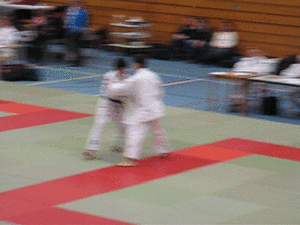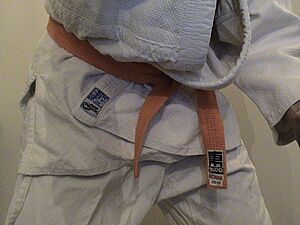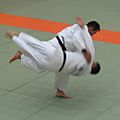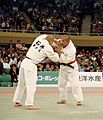Judo facts for kids
 |
|
|---|---|
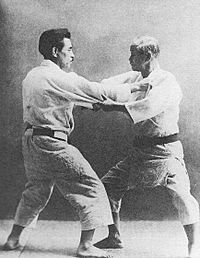
Kyuzo Mifune (left) and Kanō Jigorō (right)
|
|
| Focus | Grappling |
| Hardness | Full contact |
| Country of origin | |
| Creator | Kanō Jigorō |
| Parenthood | Various koryū jujutsu schools, principally Tenjin Shin'yō-ryū and Kitō-ryū |
| Descendant arts | Bartitsu, Brazilian jiu-jitsu, Hapkido, Kosen judo, Krav Maga, Kūdō, Modern arnis, Sambo,Shoot wrestling, Submission wrestling, Vale tudo |
| Olympic sport | Since 1964 (men) and 1992 (women) |
| Official website | International Judo Federation (IJF) The Kodokan |
Judo is an unarmed modern Japanese martial art, combat sport, Olympic sport (since 1964), and the most prominent form of jacket wrestling competed internationally. Judo was created in 1882 by Kanō Jigorō. A judo practitioner is called a "judoka" (柔道家, jūdōka, lit. 'judo performer'), and the judo uniform is called "judogi" (柔道着, jūdōgi, lit. 'judo attire').
The objective of competitive judo is to throw an opponent, immobilize them with a pin, or force an opponent to submit with a joint lock or a choke. While strikes and use of weapons are included in some pre-arranged forms (kata), they are not frequently trained and are illegal in judo competition or free practice. Judo's international governing body is the International Judo Federation, and competitors compete in the international IJF professional circuit.
Judo's philosophy revolves around two primary principles: "Seiryoku-Zenyo" (精力善用, lit. 'good use of energy') and "Jita-Kyoei" (自他共栄, lit. 'mutual welfare and benefit'). Judo also spawned a number of derivative martial arts around the world, such as Brazilian jiu-jitsu, Krav Maga, sambo, and ARB. Judo also influenced other combat styles such as close-quarters combat (CQC), mixed martial arts (MMA), shoot wrestling and submission wrestling.
Rank and grading
Judo is a hierarchical art, where seniority of judoka is designated by what is known as the nihongo ranking system. This system was developed by Jigoro Kano. Beginning students progress through various grades.
A judoka's position within the kyu-dan ranking system is displayed by the color of their belt. Beginning students typically wear a white belt, progressing through ranks until they are deemed to have achieved a level sufficient to be a dan grade, at which point they wear the Black belt. The kyu-dan ranking system has since been widely adopted by modern martial arts.
Judogi (uniform)
Judo practitioners traditionally wear white uniforms called 稽古着 (keikogi, keikogi) practice clothing or jūdōgi (柔道着, judogi, judo clothing) sometimes abbreviated in the west as "gi". It comprises a heavy cotton kimono-like jacket called an uwagi (上衣, jacket), similar to traditional hanten (半纏, workers' jackets) fastened by an obi (帯, obi, belt), coloured to indicate rank, and cotton draw-string zubon (ズボン, trousers). Early examples of keikogi had short sleeves and trouser legs and the modern long-sleeved judogi was adopted in 1906.
The modern use of the blue judogi for high level competition was first suggested by Anton Geesink at the 1986 Maastricht IJF DC Meeting. For competition, a blue judogi is worn by one of the two competitors for ease of distinction by judges, referees, and spectators. In Japan, both judoka use a white judogi and the traditional red obi (based on the colors of the Japanese flag) is affixed to the belt of one competitor. Outside Japan, a colored obi may also be used for convenience in minor competitions, the blue judogi only being mandatory at the regional or higher levels, depending on organization. Japanese practitioners and traditionalists tend to look down on the use of blue because judo is considered a pure sport, and replacing the pure white judogi with the impure blue is an offense.
For events organized under the auspices of the International judo Federation (IJF), judogi have to bear the IJF Official Logo Mark Label. This label demonstrates that the judogi has passed a number of quality control tests to ensure it conforms to construction regulations ensuring it is not too stiff, flexible, rigid or slippery to allow the opponent to grip or to perform techniques.
World Judo Day
On October 28 of every year, the judo community celebrates the World Judo Day in the honor of the birth of Judo's founder, Jigoro Kano. The theme of the World Judo Day changes from year to year, but the goal is always to highlight the moral values of Judo. The first celebration was held in 2011.
Related pages
Images for kids
-
Kanō Jigorō and Yamashita Yoshitsugu performing Koshiki-no-kata
-
International judo camp in Artjärvi, Orimattila, Finland
See also
 In Spanish: Judo para niños
In Spanish: Judo para niños


